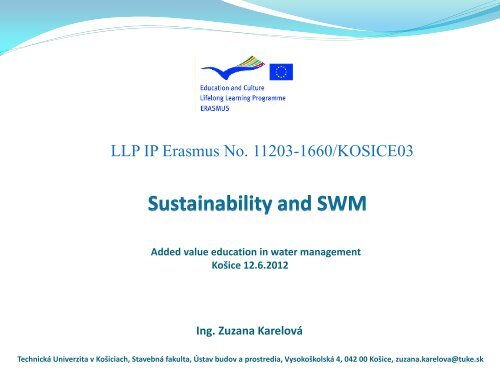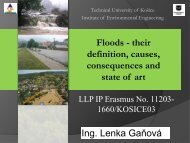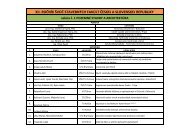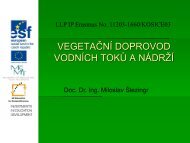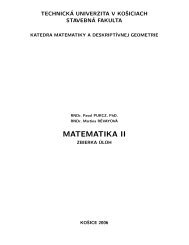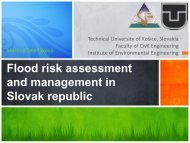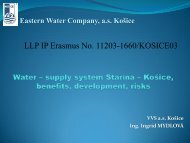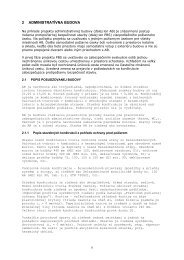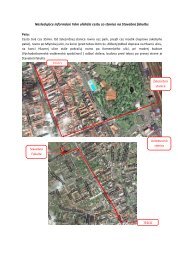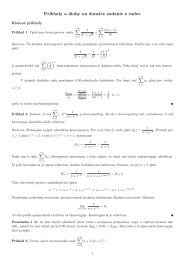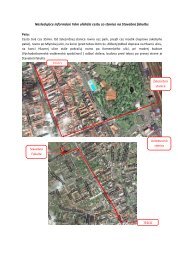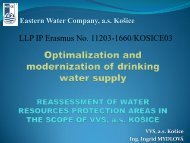Sustainability and SWM - Stavebná fakulta TUKE
Sustainability and SWM - Stavebná fakulta TUKE
Sustainability and SWM - Stavebná fakulta TUKE
You also want an ePaper? Increase the reach of your titles
YUMPU automatically turns print PDFs into web optimized ePapers that Google loves.
LLP IP Erasmus No. 11203-1660/KOSICE03<br />
Added value education in water management<br />
Košice 12.6.2012<br />
Ing. Zuzana Karelová<br />
Technická Univerzita v Košiciach, Stavebná <strong>fakulta</strong>, Ústav budov a prostredia, Vysokoškolská 4, 042 00 Košice, zuzana.karelova@tuke.sk
INTRODUCTION<br />
• Stormwater management is a process employing various non-structural <strong>and</strong><br />
structural measures to control stormwater runoff with respect to its quantity <strong>and</strong><br />
quality. (Marsalek <strong>and</strong> Chocat, 2002)<br />
• Urban drainage systems can be divided into two most commonly used; combined<br />
sewer system <strong>and</strong> separate sewer system.<br />
• Combined sewer systems convey stormwater <strong>and</strong> waste water away in one pipe. Where<br />
there are combined systems, there is a risk of combined sewer overflows (CSO) which<br />
represents transfers of untreated waste water to receiving waters (Semadeni-Davies,<br />
Bengtsson, 2000).<br />
• Whereas separate sewer system carry stormwater <strong>and</strong> waste water in separate pipes,<br />
usually laid side-by-side (Butler, Davies, 2011).<br />
• Majority of drainage systems in Slovakia are combined. Nowadays we know that<br />
this kind of system is economically <strong>and</strong> environmentally inefficient <strong>and</strong> in many<br />
cases causes overloading sewerage systems <strong>and</strong> treatment plants as more frequent<br />
floods prove it. It is essential that we introduce new sustainable approaches in<br />
urban drainage systems in Slovakia as well.
STORMWATER MANAGEMENT (<strong>SWM</strong>) - influences<br />
• There are at least two very important facts which need to be<br />
considered when dealing with the <strong>SWM</strong>.<br />
• It is increasingly changing climate, resulting in short term but more<br />
intensive precipitation in one h<strong>and</strong> <strong>and</strong> increasing droughts in some<br />
countries in the other.<br />
• The second fact is increasing urbanization over the last years which has<br />
changed the natural water processes <strong>and</strong> increased the urban runoff<br />
significantly.<br />
• These facts have influenced urban drainage <strong>and</strong> it is assumed<br />
that they will influence it even more in the future.
<strong>SWM</strong> – past <strong>and</strong> present<br />
• Pervious paradigms in <strong>SWM</strong><br />
• #1 Run It In Ditches<br />
• #2 Run It In Pipes<br />
• #3 Run It In Stormwater Pipes<br />
• #4 Keep It From Stormwater Pipes<br />
• #5 Well, Just Do Not Cause Flooding<br />
• Future paradigms in <strong>SWM</strong><br />
• #6 Do Not Pollute<br />
• #7 It Is The Ecology<br />
• #8 Water Is Water Is Watershed<br />
• #9 Green And Bear It<br />
Source: (Debo <strong>and</strong> Reese, 2003)<br />
• 10 basic contemporary <strong>SWM</strong> principles:<br />
• 1. Managing stormwater as a resource;<br />
• 2. Preserving <strong>and</strong> utilizing existing natural<br />
features <strong>and</strong> systems;<br />
• 3. Managing stormwater as close to the source<br />
as possible;<br />
• 4. Sustaining the hydrologic balance of surface<br />
<strong>and</strong> ground water;<br />
• 5. Disconnecting, decentralizing <strong>and</strong><br />
distributing sources <strong>and</strong> discharges;<br />
• 6. Slowing runoff down, <strong>and</strong> not speeding it<br />
up;<br />
• 7. Preventing potential water quality <strong>and</strong><br />
quantity problems;<br />
• 8. Minimizing problems that cannot be<br />
avoided;<br />
• 9. Integrating stormwater management into<br />
the initial site design process<br />
• 10. Inspecting <strong>and</strong> maintaining all BMPs.<br />
Source: (Pennsylvania Stormwater BMPs, 2006)
SUSTAINABILITY IN <strong>SWM</strong><br />
• There are different names for more sustainable drainage mechanisms in different<br />
countries:<br />
• BMPs - Best Management Practices,<br />
• SUDS - Sustainable Urban Drainage Systems,<br />
• LID - Low impact development,<br />
• Sustainable approach to urban drainage can be according to Stahre<br />
divided into four parts of where we dispose stormwater:<br />
• Source control<br />
• Onsite control<br />
• Slow transport<br />
• Downstream control<br />
Source Control<br />
examples<br />
Green roofs<br />
Surface<br />
percolation<br />
Swale<br />
percolation<br />
Bioretention<br />
Rainwater<br />
Harvesting<br />
Source: Stahre (2006)
RAINWATER HARVESTING (RWH)<br />
• Rainwater harvesting is not only the part of source control measure in the<br />
<strong>SWM</strong>, it is also the way<br />
• how to control water consumption <strong>and</strong><br />
• how to support qualitative <strong>and</strong> reasonable water use for different purposes.<br />
• One of the objectives of the Water Framework Directive is to promote sustainable<br />
water use, based on long-term protection of available water resources <strong>and</strong> we<br />
can say that RWH contributes to this objective.<br />
• Rainwater could replace potable water in the following cases: flushing toilets,<br />
maintenance <strong>and</strong> cleaning, irrigation, washing vehicles, process water or fire water.<br />
• Before designing the system, it’s necessary to define the rainwater dem<strong>and</strong> <strong>and</strong><br />
then determine storage capacity regarding effectiveness, reliability <strong>and</strong> total cost.
RAINWATER HARVESTING (RWH)<br />
Rain <strong>and</strong> stormwater harvesting contribute to the integrated management of URBAN WATER CYCLE.<br />
• It has direct impact on volume <strong>and</strong> quality of stormwater runoff ,<br />
• reduction in flows to wastewater treatment plants (WWTP),<br />
• <strong>and</strong> it of course conserves drinking water.<br />
Source: (Scholes, 2007)<br />
Table shows water<br />
reuse matrix for<br />
commercial purposes<br />
Adapted from: (Guenter Hauber-Davidson )
RWH – examples<br />
• Systems using alternative water sources are well known in many countries. There are<br />
many case studies aimed not only at rainwater <strong>and</strong> storm water usage, they are<br />
concerned in recycling <strong>and</strong> reuse e.g. of gray water <strong>and</strong> combined systems of rainwater<br />
<strong>and</strong> gray water or respectively <strong>and</strong> its reliability <strong>and</strong> economic effectiveness as<br />
performed Ghisi et al. (2007 a,b).<br />
• Based on foreign case studies, it is possible to figure that household’s savings of potable<br />
water could rise up to 60% for family houses <strong>and</strong> apartment houses. In the apartment<br />
houses, water consumption increases in dependence on number of dwelling units <strong>and</strong><br />
surrounded areas needed to be irrigated. This particular case study is from Norrköping<br />
in Sweden, where different alternatives of rainwater usage had also been considered.<br />
(Villareal, Dixon, 2005)<br />
• More <strong>and</strong> more case studies apply rainwater harvesting for other kinds of buildings<br />
instead of residential buildings. Very interesting example is from the capital of Brazil,<br />
where the usage of rainwater at petrol station for car washing could save from 7,4% to<br />
57,2% of water. (Ghisi, 2009)<br />
• Nowadays, the rainwater collection system is a common part of new architectural<br />
designs of the buildings such as “The bird’s nest” (Beijing National Stadium), The<br />
Millennium Dome in Greenwich London, Daimler Chrysler buildings in Berlin <strong>and</strong> sport<br />
facilities for winter Olympic games 2010 in Vancouver. Most of the buildings use<br />
harvested water for toilet flushing <strong>and</strong> irrigation.
QUESTIONNAIRE<br />
Questionnaire, as one of data collection methods helps us to gather the essential information.<br />
This questionnaire gives us closer look on people’s attitude to RWH <strong>and</strong> their water<br />
consumption habits.<br />
Number of respondents: 50<br />
Number of questions: 26<br />
Questionnaire performed on: spring 2010<br />
Men/women: 34/66%<br />
Age: 46% (20-30), 20% (31-40), 22% (41-50), 8% (51-60), 4% (61- )<br />
100% - use potable water for all domestic purposes (toilet flushing including)<br />
46 % - of the respondents have dual flash tank<br />
The result is that most of our citizens are pro water saving oriented <strong>and</strong> open to new water<br />
ideas.
RAINFALL AMOUNTS MEASURED AT THE <strong>TUKE</strong> CAMPUS<br />
Rainfall amounts measured at the <strong>TUKE</strong> campus from April 2011 to December 2011 are shown<br />
13,00<br />
154,20<br />
117,20<br />
83,40<br />
33,40 20,80 24,60 0,00<br />
54,40<br />
Data from <strong>TUKE</strong> campus<br />
90,520 90,840<br />
68,260<br />
42,600<br />
72,520<br />
62,240<br />
43,920<br />
32,180 28,080<br />
Average rainfall<br />
2004 – 2009 (data<br />
from: SHMÚ)
mm<br />
2:15:00<br />
2:50:00<br />
3:25:00<br />
4:00:00<br />
4:35:00<br />
5:10:00<br />
5:45:00<br />
6:20:00<br />
6:55:00<br />
7:30:00<br />
8:05:00<br />
8:40:00<br />
9:15:00<br />
9:50:00<br />
10:25:00<br />
11:00:00<br />
11:35:00<br />
12:10:00<br />
12:45:00<br />
13:20:00<br />
13:55:00<br />
14:30:00<br />
15:05:00<br />
15:40:00<br />
RAINFALL AMOUNTS MEASURED AT THE <strong>TUKE</strong> CAMPUS<br />
154,20<br />
13,00<br />
5,00<br />
4,50<br />
4,00<br />
3,50<br />
3,00<br />
2,50<br />
2,00<br />
1,50<br />
1,00<br />
0,50<br />
0,00<br />
83,40<br />
117,20<br />
33,40<br />
20,80 24,60<br />
0,00<br />
54,40<br />
day<br />
mm/day<br />
02.07.11 10,80<br />
04.07.11 0,40<br />
05.07.11 7,20<br />
06.07.11 7,20<br />
08.07.11 2,40<br />
11.07.11 13,60<br />
12.07.11 0,20<br />
18.07.11 0,20<br />
19.07.11 0,40<br />
20.07.11 7,20<br />
21.07.11 20,00<br />
22.07.11 8,20<br />
24.07.11 3,40<br />
25.07.11 14,00<br />
26.07.11 19,20<br />
27.07.11 9,80<br />
28.07.11 5,00<br />
29.07.11 3,20<br />
30.07.11 16,80<br />
31.07.11 5,00<br />
hour
RAINWATER HARVESTING POTENTIAL<br />
One of the ways how to promote sustainability in <strong>SWM</strong> is rainwater harvesting. It is<br />
possible to use rainwater instead of potable water anywhere where there is no need for<br />
such high quality water for example for flushing toilets, cleaning <strong>and</strong> maintenance, car<br />
washing, irrigation, laundry etc.<br />
The volume of rainwater depends on the area, rainfall, size of<br />
the roof <strong>and</strong> the runoff coefficient. We can calculate it<br />
according to the following formula<br />
Q m = Ψ . A . Z M (m 3 /month)<br />
Ψ – runoff coefficient ( - )<br />
A – roof area ( m 2 )<br />
Z M – monthly rainfall (mm/month = l/m 2 .month)<br />
13,00<br />
83,40<br />
117,20<br />
154,20<br />
33,40 20,80 24,60 0,00<br />
54,40<br />
roof shape<br />
flat<br />
sloped<br />
roof<br />
covering<br />
runoff<br />
coefficie<br />
nt<br />
metal 0,7<br />
asphalt 0,6<br />
plastic 0,7<br />
roof tile 0,8<br />
concrete 0,8<br />
slate 0,8<br />
wood 0,75<br />
metal 0,9<br />
plastic 0,9<br />
Source: Hlavínek a kol. (2007)<br />
DIN 1989 Regenwassernutzungsanlagen,<br />
precipitation measured at the university campus from April to<br />
December 2011
RAINWATER HARVESTING POTENTIAL<br />
Examples of potential volume of rainwater<br />
in m 3 from the roofs of different sizes <strong>and</strong><br />
different runoff coefficients during July<br />
2011 at the <strong>TUKE</strong> campus<br />
ψ<br />
roof area m 2<br />
10 50 100 150<br />
1,00 1,54 7,71 15,42 23,13<br />
0,90 1,39 6,94 13,88 20,82<br />
0,80 1,23 6,17 12,34 18,50<br />
0,70 1,08 5,40 10,79 16,19<br />
ψ<br />
roof area m 2<br />
200 250 300 350<br />
1,00 30,84 38,55 46,26 53,97<br />
0,90 27,76 34,70 41,63 48,57<br />
0,80 24,67 30,84 37,01 43,18<br />
0,70 21,59 26,99 32,38 37,78<br />
ψ<br />
roof area m 2<br />
400 450 500 550<br />
1,00 61,68 69,39 77,10 84,81<br />
0,90 55,51 62,45 69,39 76,33<br />
0,80 49,34 55,51 61,68 67,85<br />
0,70 43,18 48,57 53,97 59,37<br />
average water dem<strong>and</strong> for:<br />
flushing toilets<br />
cleaning<br />
washing<br />
irrigation<br />
flushing toilet - student<br />
flushing toilet - employee<br />
washing a car<br />
washing a truck<br />
washing a bus<br />
amount<br />
45 l/person.day<br />
6 l/person. day<br />
15 l/ person. day<br />
60 l/m2.rok<br />
6 l/ student. day<br />
12 l/ employee. day<br />
200 l/wash<br />
700 l/wash<br />
1000 l/wash<br />
Source:<br />
Hlavínek a kol. (2007),<br />
DIN 1989 Regenwassernutzungsanlagen,<br />
vyhláška 684/2006
SOURCES<br />
• Marsalek, J. <strong>and</strong> Chocat, B. (2002), International Report: Stormwater management, Water Science <strong>and</strong> Technology Vol 46<br />
No 6–7 pp 1–17<br />
• Semadeni-Davies, A. <strong>and</strong> Bengtsson L. (2000), Theoretical Background, Chapter 1 in: Urban Drainage in Specific Climates,<br />
Vol II. Urban Drainage in Cold Climate, IHP-V Technical Documents in Hydrology, No. 40, UNESCO, Paris<br />
• Butler, D. <strong>and</strong> Davies, J. W. (2011), Urban Drainage, 3rd Edition, Spon Press an imprint of Taylor & Francis, ISBN 978-0-415-<br />
45526-8<br />
• Debo, T. N. <strong>and</strong> Reese , A. J. (2003), Municipal Stormwater Management, 2nd ed., CRC Press LLC, ISBN 1-56670-584-3<br />
• Pennsylvania Stormwater Best Management Practices Manual (2006), Chapter 3, Stormwater Management Principles <strong>and</strong><br />
Recommended Control Guideline, online: http://www.elibrary.dep.state.pa.us/dsweb/Get/Version-<br />
48474/04_Chapter_3.pdf<br />
• Stahre, P. (2006), <strong>Sustainability</strong> in Urban Storm Drainage, Planning <strong>and</strong> examples, Svenskt Vatten, ISBN 91-85159-20-4<br />
• The Water Framework Directive 2000/60/EC<br />
• Guenter Hauber-Davidson Supplementing Urban Water SuppliesT hrough Industrial <strong>and</strong> Commercial Rainwater Harvesting<br />
Schemes, http://www.watergroup.com.au/download/P_RWH-integrUrbWatSuplyGHDv1a070308.pdf<br />
• Scholes, L. (2007), Stormwater reuse: why, how <strong>and</strong> where, SWITCH - presentation, online:<br />
http://switchurbanwater.lboro.ac.uk/outputs/pdfs/WP2-1_PRS_Stormwater_reuse.pdf<br />
• Ghisi, E., Ferreira, D. F. (2007 a), Potential for potable water savings by using rainwater <strong>and</strong> greywater in a multi-storey<br />
residential building in southern Brazil, Building <strong>and</strong> Environment 42 (2007) 2512–2522<br />
• Ghisi, E., Mengotti de Oliveira, S. (2007 b), Potential for potable water savings by combining the use of rainwater <strong>and</strong><br />
greywater in houses in southern Brazil, Building <strong>and</strong> Environment 42 (2007) 1731–1742<br />
• Ghisi E, et al. (2009), Rainwater harvesting in petrol stations in Brasília: Potential for potable water savings <strong>and</strong> investment<br />
feasibility analysis, Resources, Conservation <strong>and</strong> Recycling<br />
• SHMÚ – Košice rainfall data from Slovak Hydrometeorological Institute<br />
• Hlavínek P. a kol. (2007), Hospodaření s dešťovými vodami v urbanizovaném území, ARDEC s.r.o., ISBN 80-86020-55-X
Thank you for your attention


